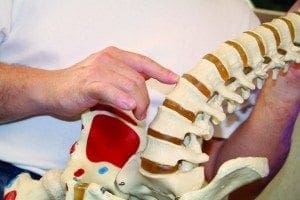Chiropractors regularly treat sciatica and have terrific results.
Sciatica is the Latin word for “Pain down the back of the leg” Sciatica is referred pain usually caused by trapping the sciatic nerve in the lower back. See back pain.
The sciatic nerve runs from the lower back down through the buttocks and along the back of each leg. Sciatica is pain along this nerve and is a relatively common form of back pain and is usually caused by pressure on the sciatic nerve from a herniated or bulging disc.
The pain from sciatica can be anything from infrequent and irritating to severe and debilitating. Usually, it affects only one side, the pain radiating through the buttock and down the leg and is often associated with a constant pain on one side of the buttocks, pain in the leg and/or buttock that may be worse when sitting , burning or tingling down the leg, weakness, numbness or difficulty moving the leg or foot or a shooting pain that makes it difficult to stand up.
While sciatica can be extremely painful and uncomfortable, it is rare that permanent nerve damage (tissue damage) results. Most pain is due to inflammation and will improve within a period of time. Nerve pain is caused by a combination of pressure and inflammation on the nerve root, and treatment is centred on relieving both of these conditions.
Typically, sciatica is made worse by bending, lifting, sneezing and coughing.
Sciatica is a common problem for manual workers, sedentary office workers and is particularly prevalent during pregnancy.
[site_discipline] Treatment main objectives are
- reduce pain
- restore movement
- strengthen weakened muscles
- reduce tension
Causes of Sciatica
The sciatic nerve is the main nerve in the leg and the largest in the body. It runs from the base of the spine, along the back of the thigh to the knee, where it divides into branches.
Sciatic pain is usually caused by compression of this nerve root at the point where it leaves the spine. Damage to the nerve can also cause pain.
In young and early middle-aged adults, the most common cause of sciatica is a prolapsed intervertebral disc in the lumbosacral area of the lower back.
In older people, changes in the spine due to conditions such as osteoarthritis may be responsible either by causing localised pressure on the nerve or by narrowing of the spinal canal – called spinal stenosis.
Other bone disease or local injury may also be responsible.
Pressure on the sciatic nerve can result from a number of reasons including
- Sometimes, just sitting awkwardly can cause sciatica.
- Piriformis syndrome (tightness of the piriformis muscle in the buttock that compresses the sciatic nerve)
- Spinal misalignments, vertebral dysfunction
- herniated disc
- Poor posture – wearing high heels, prolonged sitting, poor mattress
- Poor lifting technique and poor bending habits
- Spinal compressions due to osteoporosis
Diagnosis of Sciatica
Since there are many disorders that can cause sciatica, your [site_profession]s’ first task is to determine the exact cause of your sciatic nerve interference.
[site_discipline] treatment
- Always begins with a thorough history,
- Spinal, orthopaedic and neurological examination.
- Special diagnostic imaging investigations such as X-ray, CT, MRI
- Posture pro scan may also be required to accurately diagnose your sciatica.
Treatment of Sciatica
As sciatica is due to pressure on the sciatic nerve, it stands to reason that treatment involves removing this pressure. Your [site_discipline] treatment aims to achieve this by reducing nerve pressure caused by poorly moving spinal joints as well as easing muscular tension in the lower spine, buttock and leg.
This is achieved by using a combination of the following techniques:
- Spinal mobilisations
- Massage therapy and trigger point therapy
- Stretching tight muscles, joints, tendons and ligaments
- Ultrasound and other electrical stimulation devices
- Advice in relation to how to minimise pressure and irritation of the sciatic nerve
In addition to this, you will be given a series of home stretching exercises and asked to apply ice and heat to help aid your recovery.
If you are suffering with sciatica at the moment please do not delay – you can achieve the best results when you address the symptoms early!
For further information, or to consult with one of our skilled [site_profession]s you can use the Contact Us or Appointment Request buttons at the top or bottom of this page, call our [site_location] practice on [site_phone], or visit [site_title]’s state of the art [site_discipline] clinic at [site_address_line] in [site_location].
Sciatica & Chiropractic
Sciatica occurs when this nerve is compressed, irritated, or inflamed. The typical referral pain of sciatica pain begins in your back or buttocks and moves down the back of your leg, radiating around the outside of your knee and lower leg into your big toe and second toe. Weakness, tingling, or numbness in the leg may also occur.
The effects of sciatic pain penetrate every aspect of life. Everyday life becomes a chore when suffering from sciatic pain; even simple tasks such as getting out of bed, coughing sneezing or even using the bathroom can become a painful experience. Those in acute Sciatic pain understand how debilitating it can be, affecting every aspect of your personal and professional life. The emotional effects can be devastating as pain restricts our ability to truly enjoy life.
Sciatica’s damage is an accumulation of a lifetime of neglect and improper care of the lumbar spine. With this in mind, it is essential for proper care and maintenance of the lumbar spine to prevent Sciatica from ever taking place. When Sciatica is first suspected, it is crucial that care begin immediately to prevent permanent damage or damage that requires dangerous invasive medical attention.
Many times people with sciatica wait until the pain becomes unbearable before they contact the chiropractor. Waiting can cause long-term damage. It is important that you contact your chiropractor when the pain originally begins. The first thing your chiropractor will do is review your complete health history to determine when the problem began and the possible causes. Then a complete physical and chiropractic exam is performed, and x-rays may be taken. Your chiropractor will review and discuss the results with you and make recommendations for care.
The Chiropractic approach does not cover up the symptoms associated with Sciatica, but actually finds and takes care of the underlying causes. If nerve supply is diminished at all it must be restored so the body can repair and function optimally. Along with proper chiropractic adjustments, a program of rehabilitation is prescribed to maximise soft tissue healing and to build strength and stability to the area to prevent future injuries. .


